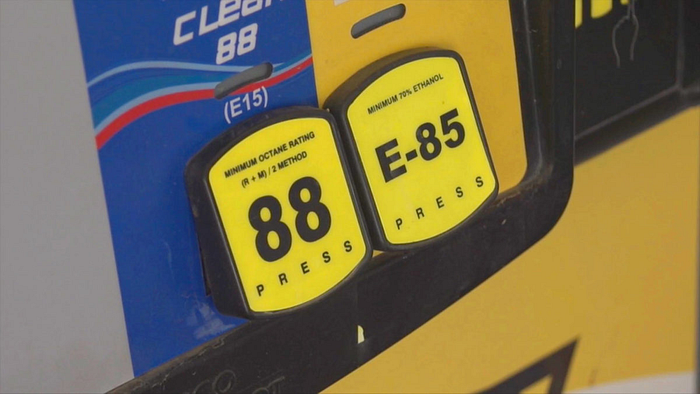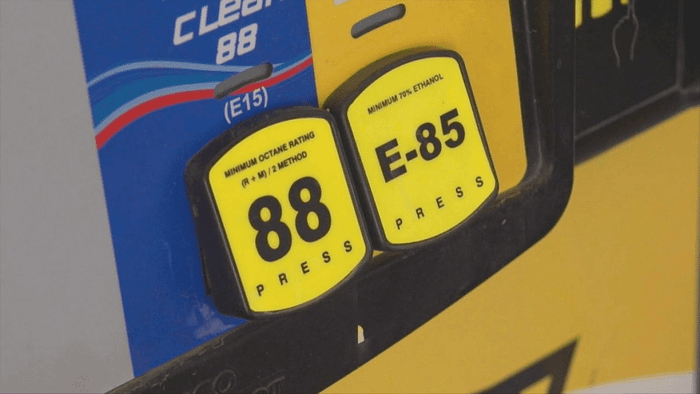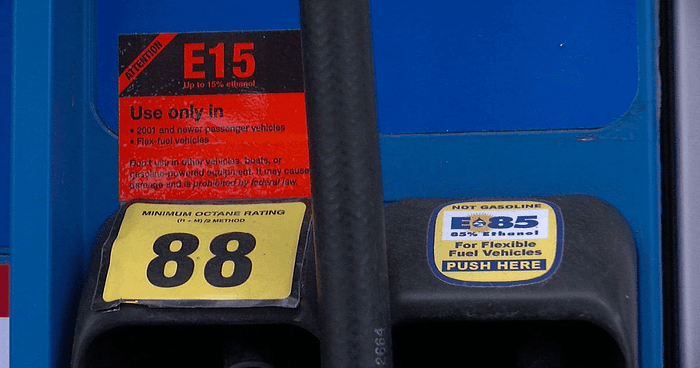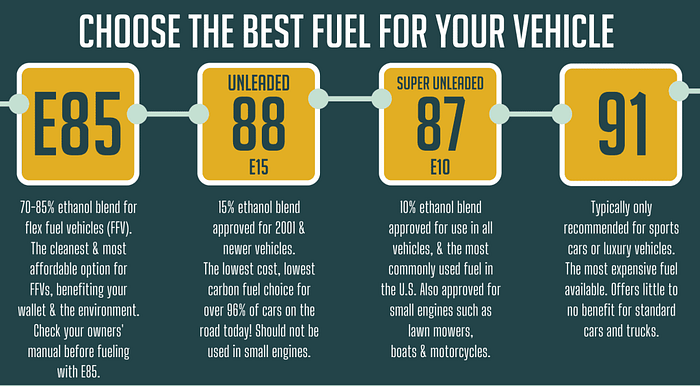
Many drivers notice different grades of fuel displayed on pump handles like E85 and Unleaded 88. The key difference lies in the amount of ethanol mixed into the gasoline. Higher ethanol ratios impact efficiency, emissions, compatibility, and more. Understanding the pros and cons helps choose the optimal fuel blend for your vehicle.

Introduction to Ethanol in Gasoline
Ethanol is a plant-derived alcohol blended into gasoline to reduce reliance on crude oil. It also decreases harmful tailpipe emissions. The percentage of ethanol determines the fuel grade designation:
- E10 — Gasoline containing up to 10% ethanol. The standard fuel sold as regular unleaded.
- E15 — Contains between 10% — 15% ethanol. Approved for use in most vehicles 2001 or newer.
- E85 — Includes 51% to 83% ethanol, making it very high in renewable alcohol content. Categorized as a specialized “flex fuel”.
- Unleaded 88 — Gasoline containing up to 15% ethanol to achieve an 88 octane rating. Available at select stations.
Higher ethanol content like E85 and Unleaded 88 offer some potential advantages but also important usage considerations compared to standard E10 regular gasoline.

What is E85 Flex Fuel?
E85 represents a gasoline-ethanol blend containing between 51% and 83% ethanol. The actual percentage varies by season and geography to maintain performance properties. The “flex fuel” label signifies engines capable of using this high ethanol gasoline.
E85 advantages:
- Uses more renewable fuel and less crude oil than standard gasoline
- Produces lower greenhouse gas emissions
- Costs less per gallon than regular gasoline (but with lower fuel economy)
However, E85 has significant downsides that limit suitability as everyday fuel for most drivers:
Requires a Flex Fuel Vehicle
The high ethanol concentration makes E85 incompatible with conventional engines. Only flex fuel vehicles specifically designed for E85 can utilize this gasoline blend. Using it in a regular engine risks severe damage.
FFV models must have upgraded fuel lines, sensors, and injection systems resilient against corrosion from ethanol. Carmakers began producing some FFV models in the late 1990s, but they still represent under 5% of US vehicles today.
Substantially Reduces Fuel Efficiency
The lower energy density of ethanol translates to 15–30% fewer miles per gallon using E85 versus standard gasoline. The exact decrease depends on the ethanol ratio, driving style, and vehicle. More ethanol means worse gas mileage.
For example, a flexible fuel car getting 28 combined mpg on regular gasoline would achieve only around 22–24 mpg on average running E85. The discount per gallon does not offset this major efficiency loss for most drivers.
Less Widely Available at Fuel Stations
Only about 3% of US gas stations sell E85 alongside regular gasoline. It is primarily available in Midwestern corn belt states which produce high volumes of ethanol domestically. Limited accessibility further restricts usability for general consumers.
E85 rewards only a small subset of drivers with compatible FFVs located near ethanol fueling stations. The niche status makes it unfeasible as a full gasoline replacement in most situations.
Overview of New Unleaded 88 Fuel
Unleaded 88 represents another ethanol blend gaining availability designed to appeal to a wider range of consumers:
- Contains up to 15% ethanol — More than standard 10% E10 fuel but less than 51%-83% in E85 flex fuel.
- Works in most modern vehicles — Does not require a specialized FFV system like high-ethanol E85.
- Provides 88 octane rating — Gives a modest performance boost over 87 octane regular gasoline.
Unleaded 88 aims to balance ethanol content to optimize potential benefits while remaining compatible with conventional vehicle engines.
Key Details on Unleaded 88 Gasoline Blend
Unleaded 88 possesses some key similarities and differences compared to both E10 regular fuel and high-ethanol E85:
Up to 15% Ethanol Like E15
The ethanol content in Unleaded 88 equates the maximum allowed by EPA in E15 fuel. This ratio strikes an optimal balance between performance and production efficiency while remaining compatible with mainstream vehicle engines.
Approved for Use by Most Vehicles 2001 or Newer
EPA allows E15 usage for model year 2001 and newer cars, light-duty trucks, SUVs and flex fuel vehicles. Unleaded 88 falls under the same approvals for mainstream vehicle compatibility.
However, some automakers prohibit E15 fuels for models predating 2012. Check your owner’s manual for any ethanol blend restrictions. Gas containing no more than 10% ethanol is permitted universally.
Achieves 88 Octane Rating
Adding extra ethanol boosts the octane rating of Unleaded 88 to 88 vs. 87 for regular E10. This gives a modest benefit for high-compression engines without the extreme ethanol concentration of E85.
Availability Remains Limited Like E15 and E85
Very few gas stations offer Unleaded 88 — less than 1% nationwide. Slow adoption limits access for drivers outside certain regions. But availability is improving as some major brands roll out this new ethanol blend.
For most drivers without an FFV, Unleaded 88 offers the optimal middle ground for balancing ethanol content between standard E10 gasoline and specialized high-ethanol E85.
Fuel Economy Comparison: Unleaded 88 vs E85
The critical tradeoff between ethanol blends comes down to efficiency. Mileage decreases significantly as ethanol percentages rise.
E85 Reduces MPG 15–30%
The lower energy density of ethanol compared to pure gasoline inevitably lowers miles per gallon. Most experts estimate the fuel economy decrease from E85 in the 15–30% range.
The exact impact varies based on driving conditions and the vehicle itself. Expect closer to a 30% reduction during highway driving and lighter impacts under 15% for city conditions.
Unleaded 88 Cuts MPG by Around 3–4%
The impact of Unleaded 88 on mileage is much lower thanks to greater gasoline content and lower ethanol concentration. EPA puts reduction around 3–4% compared to regular E10 fuel.
For example, a 30 mpg car on E10 would average around 29 mpg on Unleaded 88 and 21–26 mpg on high-ethanol E85, highlighting the penalty of extremely high ethanol ratios.
Emissions and Performance Impacts
Besides efficiency, ethanol content also affects tailpipe emissions along with vehicle performance.
E85 Offers the Greatest Emissions Reductions
The high renewable ethanol concentration makes E85 the clear winner for lowest greenhouse gas emissions of any fuel. Lifecycle emissions can be up to 50% lower compared to pure gasoline.
E85 also helps dilute harmful tailpipe pollutants. Nitrogen oxides drop 10% or more with high ethanol blends. Using E85 benefits the environment but sacrifices efficiency.
Unleaded 88 Provides Modest Performance Boost
The 88 octane rating gives Unleaded 88 a small advantage in preventing pre-ignition and knocks compared to 87 octane regular fuel. This allows slightly more advanced ignition timing.
Most modern engines adapt to different fuels. But Unleaded 88 gives a minor performance increment plus knock resistance for high-compression motors, without the efficiency penalty of E85.
Key Considerations for Choosing Ethanol Gasoline
Understanding compatibility along with tradeoffs between efficiency and emissions helps decide the optimal fuel blend:
E85 Requires Flex Fuel Vehicle
The paramount consideration for E85 remains possessing one of the few FFV models able to burn this specialized high ethanol fuel. Otherwise, engine damage is likely over sustained use.
Unleaded 88 Supported by Most 2001+ Vehicles
The moderate 15% ethanol content of Unleaded 88 won’t harm engines in modern cars and trucks designed for regular E10 fuel. Just confirm your owner’s manual permits E15 gasoline usage.
Factor in Pricing and Availability
Current widespread availability of E10 makes it the default choice for convenient, economical everyday fueling. Unleaded 88 and E85 require seeking out special pumps.
Weigh Miles Per Gallon Impact
Unleaded 88 offers a minor efficiency decrement versus standard fuel — only around 3%. E85’s substantial 15–30% MPG drop is untenable for most except those with easy discounted ethanol access.
Evaluating these variables for your particular needs illuminates whether investing in these emerging ethanol blends makes sense or if tried-and-true E10 gasoline remains ideal.
Finding E85 and Unleaded 88 Fuel Stations
The limited availability of E85 and Unleaded 88 means locating specialty stations offering these ethanol blends can be challenging:
Use Apps to Find Compatible Nearby Stations
Fuel finder apps like:
- My MPG
- PureGas
- NREL Alt Fuel Finder
Allow searching for stations selling specific fuels like E85 or Unleaded 88 based on your location. This saves driving around hunting for compatible pumps.
Check Gas Provider Websites for Station Lists
Major brands phasing in alternative ethanol fuels often provide station locators:
- Marathon — Unleaded 88 locator
- Sheetz — E85 station finder
- QuickTrip — E15 and Unleaded 88 fuel sites
Seek out the newest stations run by major fuel providers to increase odds of ethanol blend availability.
Use a Flex Fuel Vehicle? Get an E85 Decal for Your Windshield
Displaying an official E85 decal makes it easier for station owners to identify your FFV and justify offering E85. Decals are available from the US Department of Energy and other flex fuel advocacy groups.
Finding alternative ethanol fuel requires some research effort. But locating one trusted station solves the discovery problem going forward through brand loyalty.
Using Unleaded 88 and E85 in Older Vehicles
Drivers of older and classic vehicles face limitations on ethanol fuel mixes:
E85 Cannot Be Used in Any Conventional Vehicle
FFV systems enabling high ethanol ratios did not emerge until the late 90s. E85 usage in anything besides these specialized models invites engine damage.
Unleaded 88 Only Approved Back to 2001 Model Year
EPA allows E15 and hence 88 octane ethanol blends for 2001 and newer vehicles. Unleaded 88 eligibility aligns with these EPA fuel approvals.
Pre-2001 Vehicles Should Stick to E10 Gasoline
For vintage cars, inspect owner’s manuals to identify the maximum ethanol percentage tolerated by your fuel system. Most pre-2001 models should not exceed E10 gasoline blends to avoid corrosion issues from higher ethanol concentrations.
Fuel Cost and Environmental Impact Considerations
Two primary factors offset the efficiency disadvantages of higher ethanol fuels:
E85 Typically Costs Less Per Gallon Than Regular Gasoline
E85 prices are generally 20–30 cents lower than E10 fuel per gallon at the same station. However, the reduced MPG erodes this discount over time. Only ultra-low ethanol pricing makes E85 economically practical.
High Ethanol Blends Produce Lower Greenhouse Gas Emissions
Lifecycle carbon emissions are 20%-50% less from E85 and 15% lower for Unleaded 88 relative to pure gasoline. Lower particulate emissions also result. If you prioritize environmental impact over efficiency and pricing, high ethanol fuels deliver benefits.
Carefully weighing personal finance, efficiency, and eco-impact goals illuminates whether paying extra via reduced fuel economy for ethanol’s emissions savings makes sense based on your needs.

Is Unleaded 88 or E85 the Ideal Fuel for Your Vehicle?
Choosing ethanol-enhanced gasoline ultimately depends on your unique circumstances:
Unleaded 88 Offers a Modest Upgrade for Modern Cars
For most drivers of 2001+ model year vehicles without strict ethanol limits, the slightly higher performance and cleaner burn of Unleaded 88 provide marginal benefits over regular 87 octane gasoline. Just ensure availability before committing.
E85 Only Benefits Flex Fuel Vehicle Owners
The major compromises of using high ethanol E85 fuel pay off only for FFV drivers located near ample E85 pumps. Otherwise, steep efficiency losses overwhelm other advantages. Seek an FFV model if serious about reaping E85 benefits.
Stick to Regular E10 Gasoline as the Default
Absent specialized ethanol needs or models, reliable ole E10 provides a balanced middle ground between energy density, emissions, and compatibility suitable for the vast majority of drivers.
Evaluating mileage needs, vehicle compatibility, ethanol content priorities, and fuel pricing at local stations steers you toward the best pump for your circumstances.
FAQs
What is the difference between E85 and Unleaded 88?
E85 is a fuel blend that contains up to 85% ethanol and is primarily used in flex-fuel vehicles. Unleaded 88 is a fuel blend that contains 15% ethanol and 84 octane gasoline. The main difference between the two is the ethanol content.
Does Unleaded 88 improve performance?
Unleaded 88 does not necessarily improve performance, but it can provide slightly better fuel economy and lower emissions compared to regular unleaded gasoline. The higher octane level of Unleaded 88 can also help boost horsepower and efficiency in some vehicles.
Is Unleaded 88 better for the environment?
Unleaded 88 is considered better for the environment than regular unleaded gasoline because it contains ethanol, which is a renewable biofuel that reduces lifecycle carbon emissions and tailpipe pollution. The ethanol in Unleaded 88 also burns cleaner and cooler than regular unleaded gasoline, which can help reduce emissions and improve air quality.
What vehicles can use Unleaded 88?
Most vehicles that are designed to run on regular unleaded gasoline can also use Unleaded 88 without any issues. However, it’s important to check the owner’s manual or consult with a mechanic to ensure compatibility. Unleaded 88 is not recommended for all cars and is typically recommended for cars manufactured from 2001 and upwards and flex-fuel compatible cars.
Can all vehicles use E85?
No, not all vehicles can use E85. E85 is primarily used in flex-fuel vehicles that are designed to run on both gasoline and ethanol blends. Only a select group of cars can use E85, and vehicles should mention being able to run E85 gas around the gas cap.
https://wiack.com/e85-vs-unleaded-88/?feed_id=15093&_unique_id=64de75b84083f #Wiack #Car #CarInsurance #CarRental #CarPrice #AutoLoans
